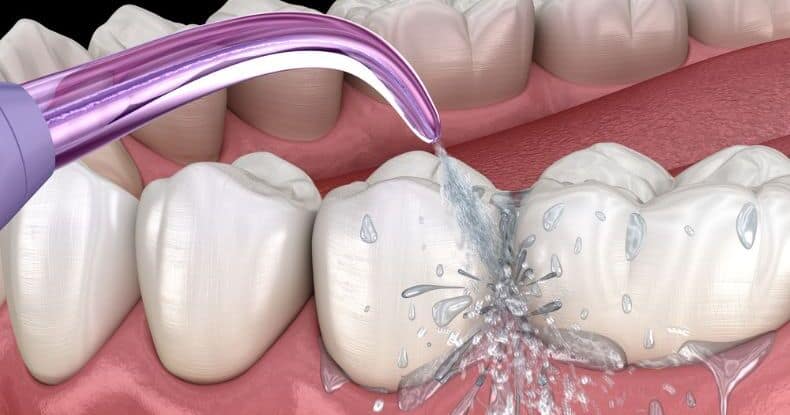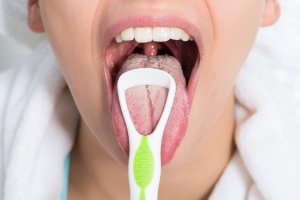Do you water floss before or after brushing your teeth? This is an important question to answer because it can affect your oral health in many different ways.
Flossing is a simple but essential part of your daily oral care routine. Brushing alone does not remove all of this plaque which can build up over time and lead to tooth decay, gingivitis, and bad breath. However, not everyone knows when to floss and whether you should floss first or brush first.
If that sounds like you, keep reading, this article will explain why it’s best to use your water flosser and brush in a particular order and answer the following questions:
- What does flossing do?
- When should you floss?
- When should you use a water flosser?
- Do you use a Waterpik before or after brushing?
Before we jump in with whether you should use a water flosser before or after you brush. Let’s get started with what water flossing is and why you should do it!
What does flossing do?
Flossing is a great way to remove food and plaque from between your teeth that your toothbrush cannot reach. It can also help prevent gum disease and tooth decay.

It’s important to floss at least once a day, but you may want to floss more often if your dentist or dental hygienist recommends it.
You can floss with regular string floss or dental tape, but string or tape can be hard to use, especially because flossing is such an important part of your oral health routine. We recommend using a water flosser instead because they are easy to use and can help remove food particles that string or tape might miss.
A water flosser, or oral irrigator, is a device that uses a stream of water to remove food and plaque from your teeth. You fill it with water or mouthwash, then push a button to release the water onto your teeth and gums.
Water flossers are easy to use—just fill the reservoir with warm water or mouthwash, put the tip in your mouth, and turn it on! They also come with tips or nozzles that are designed to reach different parts of your mouth. Some models have specialised nozzles so you can use them to water floss periodontal pockets or to flush out tonsil stones.
If you don’t already have a water flosser, some brands to check out include Waterpik, Oclean, Phillips and Panasonic. The best water flosser is the one you will use, so consider your options.
When should you floss?
Brushing your teeth is just part of good dental care. It is an effective technique to clean your teeth and gums, eliminate plaque, and prevent cavities. But it’s also important to floss your teeth to ensure optimal oral health.
Using a water flosser, such as a Waterpik, to supplement your oral hygiene routine helps to maintain proper dental health by loosening and removing plaque and food from between your teeth. Brushing also eliminates plaque and food particles, but toothbrush bristles can’t reach deep enough between teeth to remove everything.
Should you use a Waterpik before or after brushing?

We recommend using a water flosser before brushing. The reason for this is that it gets your mouth nice and clean, which means that your toothbrush can really get down to business.
You can use a water flosser after brushing, too—but the cleaning effects may not be as potent. Since the action of brushing is manual and uses up more energy than water flossing, you should make sure your mouth is completely clean before moving on to other steps in your oral care routine.
In what order should I brush, floss, and Waterpik?
The best order is to first use traditional string floss to scrape off any plaque and particles that are stuck between teeth. Next, use your Waterpik to flush the debris away. Lastly, you can use your toothbrush to clean your teeth.
Why is it better to floss before brushing?
Many people brush before they use their water flosser. The problem with this method is that any food, plaque, or germs released by flossing between your teeth stays in your mouth until you brush again.

The brushing movement eliminates these released particles from the mouth when you floss and then brush. As a consequence, your mouth will have less dental plaque and you will have a lower risk of getting gum disease.
It’s also very useful to use a water flosser with braces since it can get under the archwire and in smaller cracks.
The ideal sequence for good oral health
According to a study published in the Journal of the American Academy of Periodontology, flossing before brushing is the best way to ensure you’re getting rid of dental plaque.
When compared to the brush-then-floss group, individuals who flossed before brushing had much less plaque on their teeth and in their mouth after finishing their oral hygiene routine.
Don’t be alarmed if you’ve always used the brush-then-floss method. Flossing and brushing your teeth together every day is still an effective way to keep your mouth clean and healthy.
Benefits of using a water flosser before brushing your teeth
Flossing before brushing has been shown to have some long-term advantages on your oral health. Simply switching the sequence in which you brush your teeth may influence your dental health.
- Deep cleaning: Flossing is a good technique to get rid of germs, food debris, and other particles lodged between your teeth. If plaque bacteria is allowed to form for only 24 or 36 hours, it may swiftly damage or destroy your teeth, posing a health danger. Using a Waterpik water flosser before brushing your teeth removes plaque from all of the small cracks and crevices in your mouth.
- Increase the fluoride impact: If you want the toothpaste‘s fluoride to remain in your mouth for as long as possible to get the benefits from it, consider using a Waterpik before brushing your teeth. Your teeth are more able to absorb fluoride since plaque and bacteria have been largely eliminated by flossing.
- Avoiding gum disease: When there’s an immense amount of germs on the surface of your teeth, gum disease may develop. This is often the consequence of neglecting dental cleanings and practising poor daily dental care, such as not brushing or flossing on a regular basis. Gum disease may cause bleeding gums, loose teeth, sore gums, and bad breath, among other things. Flossing before brushing helps to remove more germs and, in the long term, lowers your risk of gum disease.
- Identify areas that need attention: If you use a water flosser before brushing your teeth, you may notice a few more details about your teeth. Flossing can often help you notice some bigger pieces of debris or a spot that needs extra attention when you brush your teeth.
What do dental professionals think about using a water flosser before brushing?
Watch this video to see what dentists believe about whether you should water floss or brush first.
Conclusion
If you’ve always used the brush-then-floss approach, don’t be concerned. No matter what order you do it, flossing and brushing your teeth together every day is still an excellent strategy to maintain a healthy mouth. However, research shows that flossing before brushing comes with some benefits.
FAQ

Should you use a water flosser before or after brushing your teeth?
It’s more beneficial to use a water flosser before brushing your teeth. Flossing before brushing lets you get rid of debris and any food particles stuck between your teeth.
Should I brush before using a water flosser?
It’s recommended to water floss with your water flosser before brushing your teeth. Brushing will be more efficient if you remove debris from your teeth before flossing.
Should I brush after using a water flosser?
Yes, it’s recommended to first water floss and then brush your teeth. Brushing your teeth after using your water flosser is the right sequence. However, both are essential for good oral health.
AAP. The effect of toothbrushing and flossing sequence. Consulted 24th August 2022.




